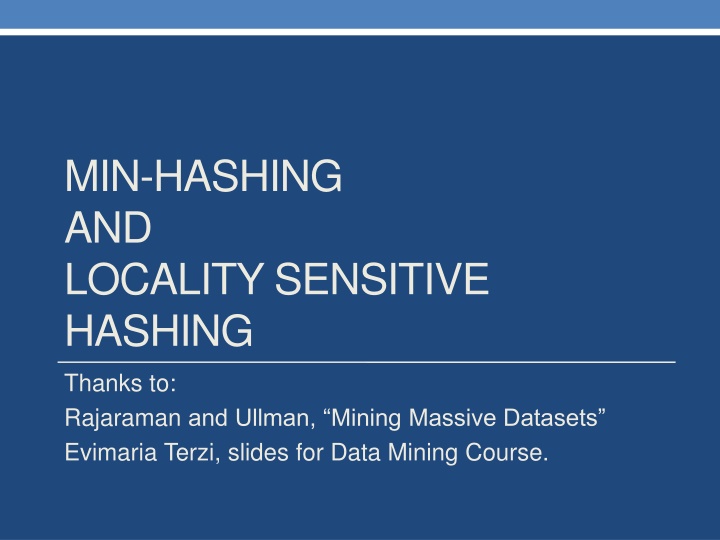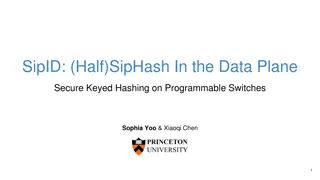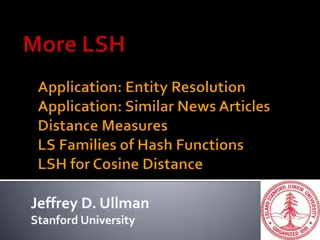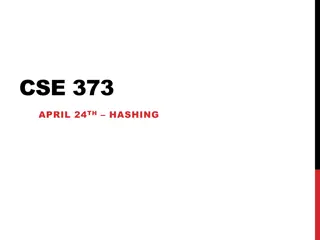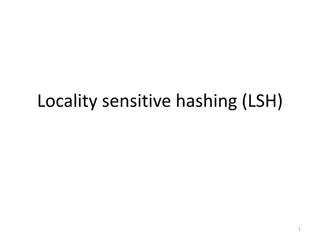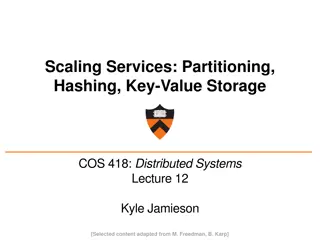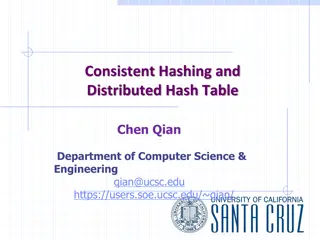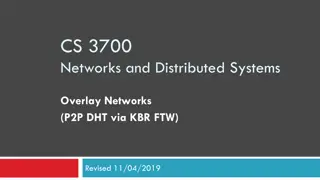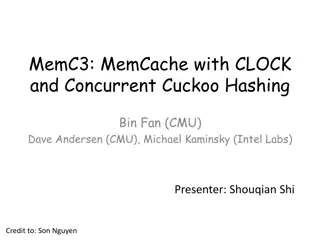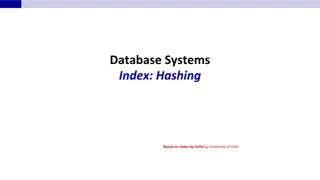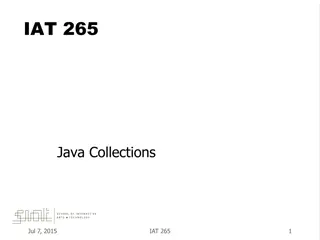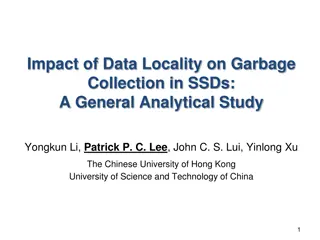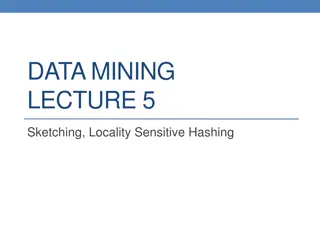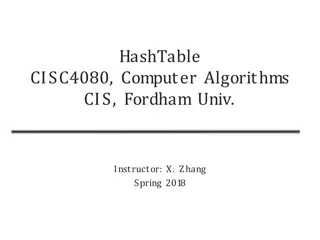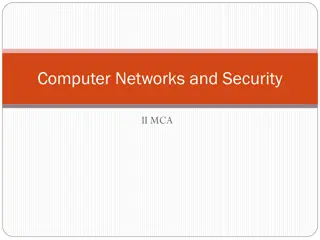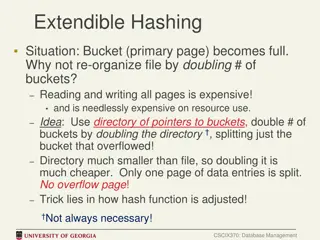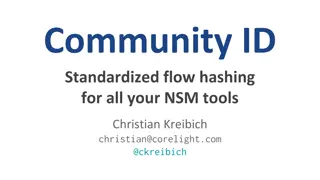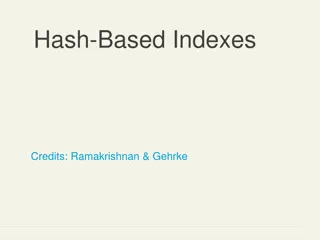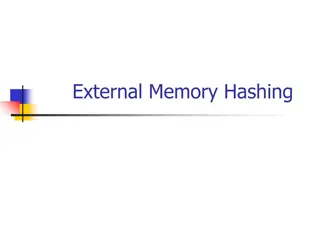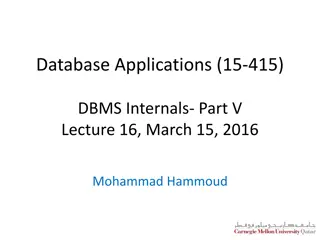Min-Hashing and Locality-Sensitive Hashing
Min-Hashing and Locality-Sensitive Hashing are techniques used to identify duplicate and near-duplicate documents efficiently, especially when dealing with massive datasets. These methods involve representing documents in a compact manner, enabling pairwise comparisons for similarity assessment. Shingling and the Jaccard similarity measure play vital roles in this process, allowing for the identification of candidate pairs with similar content. By hashing sets of shingles and generating signatures, document similarity can be accurately approximated while managing memory constraints. However, caution is needed to address false negatives and false positives that may arise during the similarity evaluation.
Download Presentation

Please find below an Image/Link to download the presentation.
The content on the website is provided AS IS for your information and personal use only. It may not be sold, licensed, or shared on other websites without obtaining consent from the author.If you encounter any issues during the download, it is possible that the publisher has removed the file from their server.
You are allowed to download the files provided on this website for personal or commercial use, subject to the condition that they are used lawfully. All files are the property of their respective owners.
The content on the website is provided AS IS for your information and personal use only. It may not be sold, licensed, or shared on other websites without obtaining consent from the author.
E N D
Presentation Transcript
MIN-HASHING AND LOCALITY SENSITIVE HASHING Thanks to: Rajaraman and Ullman, Mining Massive Datasets Evimaria Terzi, slides for Data Mining Course.
Motivating problem Find duplicate and near-duplicate documents from a web crawl. If we wanted exact duplicates we could do this by hashing We will see how to adapt this technique for near duplicate documents
Main issues What is the right representation of the document when we check for similarity? E.g., representing a document as a set of characters will not do (why?) When we have billions of documents, keeping the full text in memory is not an option. We need to find a shorter representation How do we do pairwise comparisons of billions of documents? If exact match was the issue it would be ok, can we replicate this idea?
4 The Big Picture Candidate pairs : those pairs of signatures that we need to test for similarity. Locality- sensitive Hashing Docu- ment The set of strings of length k that appear in the doc- ument Signatures: short integer vectors that represent the sets, and reflect their similarity
Shingling Shingle: a sequence of k contiguous characters Set of Shingles Set of 64-bit integers Hash function (Rabin s fingerprints) 1111 2222 3333 4444 5555 6666 7777 8888 9999 0000 a rose is rose is a rose is a ose is a r se is a ro e is a ros is a rose is a rose s a rose i a rose is
6 Basic Data Model: Sets Document: A document is represented as a set shingles (more accurately, hashes of shingles) Document similarity: Jaccard similarity of the sets of shingles. Common shingles over the union of shingles Sim (C1, C2) = |C1 C2|/|C1 C2|. Applicable to any kind of sets. E.g., similar customers or items.
Signatures Key idea: hash each set S to a small signatureSig (S), such that: Sig (S) is small enough that we can fit a signature in main memory for each set. 1. Sim (S1, S2) is (almost) the same as the similarity of Sig (S1) and Sig (S2). (signature preserves similarity). 2. Warning: This method can produce false negatives, and false positives (if an additional check is not made). False negatives: Similar items deemed as non-similar False positives: Non-similar items deemed as similar
8 From Sets to Boolean Matrices Represent the data as a boolean matrix M Rows = the universe of all possible set elements In our case, shingle fingerprints take values in [0 264-1] Columns = the sets In our case, documents, sets of shingle fingerprints M(r,S) = 1 in row r and column S if and only if r is a member of S. Typical matrix is sparse. We do not really materialize the matrix
9 Minhashing Pick a random permutation of the rows (the universe U). Define hash function for set S h(S) = the index of the first row (in the permuted order) in which column S has 1. OR h(S) = the index of the first element of S in the permuted order. Use k (e.g., k = 100) independent random permutations to create a signature.
Example of minhash signatures Input matrix S1 1 1 0 0 0 1 1 S2 0 0 1 1 1 0 0 S3 1 0 0 0 0 1 1 S4 0 1 1 1 1 0 0 S1 S2 S3 S4 1 0 0 1 1 0 1 0 1 0 0 1 0 1 A 1 2 3 4 5 6 7 1 0 1 1 0 0 0 0 1 0 0 1 1 1 A B C D E F G A C G F B E D C G F B E D 1 2 1 2
Example of minhash signatures Input matrix S1 1 1 0 0 0 1 1 S2 0 0 1 1 1 0 0 S3 1 0 0 0 0 1 1 S4 0 1 1 1 1 0 0 S1 S2 0 1 1 0 1 1 0 S3 0 0 1 0 1 1 0 S4 1 1 0 1 0 0 1 D 1 2 3 4 5 6 7 1 0 0 1 0 0 1 A B C D E F G D B A C F G E B A C F G E 2 1 3 1
Example of minhash signatures Input matrix S1 1 1 0 0 0 1 1 S2 0 0 1 1 1 0 0 S3 1 0 0 0 0 1 1 S4 0 1 1 1 1 0 0 S1 S2 0 0 1 1 1 1 0 S3 0 0 1 1 1 0 0 S4 1 1 0 0 0 1 1 C 1 2 3 4 5 6 7 1 1 0 0 0 0 1 A B C D E F G C D G F A B E D G F A B E 3 1 3 1
Example of minhash signatures Input matrix Signature matrix S1 1 1 0 0 0 1 1 S2 0 0 1 1 1 0 0 S3 1 0 0 0 0 1 1 S4 0 1 1 1 1 0 0 A B C D E F G S1 1 2 3 S2 2 1 1 S3 1 3 3 S4 2 1 1 h1 h2 h3 Sig(S) = vector of hash values e.g., Sig(S2) = [2,1,1] Sig(S,i) = value of the i-th hash function for set S E.g., Sig(S2,3) = 1
14 Hash function Property Pr(h(S1) = h(S2)) = Sim(S1,S2) where the probability is over all choices of permutations. Why? The first row where one of the two sets has value 1 belongs to the union. Recall that union contains rows with at least one 1. We have equality if both sets have value 1, and this row belongs to the intersection
Example Universe: U = {A,B,C,D,E,F,G} X = {A,B,F,G} Y = {A,E,F,G} Rows C,D could be anywhere they do not affect the probability X Y X Y Union = {A,B,E,F,G} Intersection = {A,F,G} 1 1 0 0 A D D 1 0 B * 0 0 C * 0 0 0 0 D C C 0 1 E * 1 1 F * 1 1 G *
Example Universe: U = {A,B,C,D,E,F,G} X = {A,B,F,G} Y = {A,E,F,G} The * rows belong to the union X Y X Y Union = {A,B,E,F,G} Intersection = {A,F,G} 1 1 0 0 A D D 1 0 B * 0 0 C * 0 0 0 0 D C C 0 1 E * 1 1 F * 1 1 G *
Example Universe: U = {A,B,C,D,E,F,G} X = {A,B,F,G} Y = {A,E,F,G} The question is what is the value of the first * element X Y X Y Union = {A,B,E,F,G} Intersection = {A,F,G} 1 1 0 0 A D D 1 0 B * 0 0 C * 0 0 0 0 D C C 0 1 E * 1 1 F * 1 1 G *
Example Universe: U = {A,B,C,D,E,F,G} X = {A,B,F,G} Y = {A,E,F,G} If it belongs to the intersection then h(X) = h(Y) X Y X Y Union = {A,B,E,F,G} Intersection = {A,F,G} 1 1 0 0 A D D 1 0 B * 0 0 C * 0 0 0 0 D C C 0 1 E * 1 1 F * 1 1 G *
Example Universe: U = {A,B,C,D,E,F,G} X = {A,B,F,G} Y = {A,E,F,G} Every element of the union is equally likely to be the * element Pr(h(X) = h(Y)) = | A,F,G | | A,B,E,F,G |=3 5= Sim(X,Y) X Y X Y Union = {A,B,E,F,G} Intersection = {A,F,G} 1 1 0 0 A D D 1 0 B * 0 0 C * 0 0 0 0 D C C 0 1 E * 1 1 F * 1 1 G *
20 Similarity for Signatures The similarity of signatures is the fraction of the hash functions in which they agree. S1 1 S2 0 S3 1 S4 0 Signature matrix Actual Sig A (S1, S2) (S1, S3) (S1, S4) (S2, S3) (S2, S4) (S3, S4) 0 0 S1 1 S2 2 S3 1 S4 2 B 1 0 0 1 3/5 2/3 C 0 1 0 1 1/7 0 2 1 3 1 D 0 1 0 1 0 0 3 1 3 1 E 0 1 0 1 3/4 1 F 1 0 1 0 0 0 Zero similarity is preserved High similarity is well approximated G 1 0 1 0 With multiple signatures we get a good approximation
Is it now feasible? Assume a billion rows Hard to pick a random permutation of 1 billion Even representing a random permutation requires 1 billion entries!!! How about accessing rows in permuted order?
Being more practical Instead of permuting the rows we will apply a hash function that maps the rows to a new (possibly larger) space The value of the hash function is the position of the row in the new order (permutation). Each set is represented by the smallest hash value among the elements in the set The space of the hash functions should be such that if we select one at random each element (row) has equal probability to have the smallest value Min-wise independent hash functions
Algorithm One set, one hash function Computing Sig(S,i) for a single column S and single hash function hi In practice only the rows (shingles) that appear in the data for each row r compute hi (r ) if column Sthathas 1 in row r ifhi (r ) is a smaller value than Sig(S,i)then Sig(S,i) = hi (r); hi (r) = index of row r in permutation S contains row r Find the row r with minimum index Sig(S,i) will become the smallest value of hi(r) among all rows (shingles) for which column S has value 1 (shingle belongs in S); i.e., hi (r) gives the min index for thei-th permutation
Algorithm All sets, k hash functions Pick k=100 hash functions (h1, ,hk) In practice this means selecting the hash function parameters for each row r for each hash function hi compute hi (r ) for each column Sthathas 1 in row r ifhi (r ) is a smaller value than Sig(S,i)then Sig(S,i) = hi (r); Compute hi (r) only once for all sets
25 Example Sig1 Sig2 h(0) = 1 g(0) = 3 1 3 - - Row S1 A B C D E S2 0 1 1 0 1 g(x) 3 0 2 4 1 x 0 1 2 3 4 h(x) 1 2 3 4 0 1 0 1 1 0 h(1) = 2 g(1) = 0 1 3 2 0 h(2) = 3 g(2) = 2 1 2 2 0 h(3) = 4 g(3) = 4 1 2 2 0 h(x) = x+1 mod 5 g(x) = 2x+3 mod 5 h(4) = 0 g(4) = 1 1 2 0 0 h(Row) 0 1 2 3 4 Row S1 S2 B 0 1 E 0 1 C 1 0 A 1 D 1 Row S1 S2 E 0 1 A 1 B 0 1 C 1 1 D 1 0 g(Row) 0 1 2 3 4 0 1 0
26 Implementation Often, data is given by column, not row. E.g., columns = documents, rows = shingles. If so, sort matrix once so it is by row. And always compute hi (r ) only once for each row.
27 Finding similar pairs Problem: Find all pairs of documents with similarity at least t = 0.8 While the signatures of all columns may fit in main memory, comparing the signatures of all pairs of columns is quadratic in the number of columns. Example: 106 columns implies 5*1011 column- comparisons. At 1 microsecond/comparison: 6 days.
28 Locality-Sensitive Hashing What we want: a function f(X,Y) that tells whether or not X and Y is a candidate pair: a pair of elements whose similarity must be evaluated. A simple idea: X and Y are a candidate pair if they have the same min-hash signature. Easy to test by hashing the signatures. Similar sets are more likely to have the same signature. Likely to produce many false negatives. Requiring full match of signature is strict, some similar sets will be lost. ! Multiple levels of Hashing! Improvement: Compute multiple signatures; candidate pairs should have at least one common signature. Reduce the probability for false negatives.
29 Signature matrix reminder Prob(Sig(S,i) == Sig(S ,i)) = sim(S,S ) Sig(S,i) Sig(S ,i) hash function i n hash functions Sig(S): signature for set S signature for set S Matrix M
30 Partition into Bands (1) Divide the signature matrix Sig into b bands of r rows. Each band is a mini-signature with r hash functions.
31 Partitioning into bands n = b*r hash functions r rows per band b bands b mini-signatures One signature Matrix Sig
32 Partition into Bands (2) Divide the signature matrix Sig into b bands of r rows. Each band is a mini-signature with r hash functions. For each band, hash the mini-signature to a hash table with k buckets. Make k as large as possible so that mini-signatures that hash to the same bucket are almost certainly identical.
33 Columns 2 and 6 are (almost certainly) identical. Hash Table Columns 6 and 7 are surely different. Matrix M 1 2 3 4 5 6 7 b bands r rows
34 Partition into Bands (3) Divide the signature matrix Sig into b bands of r rows. Each band is a mini-signature with r hash functions. For each band, hash the mini-signature to a hash table with k buckets. Make k as large as possible so that mini-signatures that hash to the same bucket are almost certainly identical. Candidate column pairs are those that hash to the same bucket for at least 1 band. Tune b and r to catch most similar pairs, but few non- similar pairs.
35 Analysis of LSH What We Want Probability = 1 if s > t Probability of sharing a bucket No chance if s < t t Similarity s of two sets
36 What One Band of One Row Gives You Single hash signature Remember: probability of equal hash-values = similarity Probability of sharing a bucket t Prob(Sig(S,i) == Sig(S ,i)) = sim(S,S ) Similarity s of two sets
37 What b Bands of r Rows Gives You At least one band identical No bands identical sr ( 1 - )b 1 - t ~ (1/b)1/r Probability of sharing a bucket All rows of a band are equal Some row of a band unequal t Similarity s of two sets
38 Example: b = 20; r = 5 t = 0.5 s .2 .3 .4 .5 .6 .7 .8 1-(1-sr)b .006 .047 .186 .470 .802 .975 .9996
39 Suppose S1, S2 are 80% Similar We want all 80%-similar pairs. Choose 20 bands of 5 integers/band. Probability S1, S2 identical in one particular band: (0.8)5 = 0.328. Probability S1, S2 are not similar in any of the 20 bands: (1-0.328)20 = 0.00035 i.e., about 1/3000-th of the 80%-similar column pairs are false negatives. Probability S1, S2 are similar in at least one of the 20 bands: 1-0.00035 = 0.999
40 Suppose S1, S2 Only 40% Similar Probability S1, S2 identical in any one particular band: (0.4)5 = 0.01 . Probability S1, S2 identical in at least1 of 20 bands: 20 * 0.01 = 0.2 . But false positives much lower for similarities <<40%.
41 LSH Summary Tune to get almost all pairs with similar signatures, but eliminate most pairs that do not have similar signatures. Check in main memory that candidate pairs really do have similar signatures. Optional: In another pass through data, check that the remaining candidate pairs really represent similar sets .
Locality-sensitive hashing (LSH) Big Picture: Construct hash functions h: Rd such that for any pair of points p,q, for distance function D we have: If D(p,q) r, then Pr[h(p)=h(q)] is high If D(p,q) cr, then Pr[h(p)=h(q)] is small Then, we can find close pairs by hashing U LSH is a general framework: for a given distance function D we need to find the right h h is (r,cr, , )-sensitive
43 LSH for Cosine Distance For cosine distance, there is a technique analogous to minhashing for generating a (d1,d2,(1-d1/180),(1-d2/180))- sensitive family for any d1 and d2. Called random hyperplanes.
44 Random Hyperplanes Pick a random vector v, which determines a hash function hv with two buckets. hv(x) = +1 if v.x > 0; = -1 if v.x < 0. LS-family H = set of all functions derived from any vector. Claim: Prob[h(x)=h(y)] = 1 (angle between x and y divided by 180).
45 Proof of Claim v Look in the plane of x and y. x Hyperplanes (normal to v ) for which h(x) <> h(y) Hyperplanes for which h(x) = h(y) y Prob[Red case] = /180
46 Signatures for Cosine Distance Pick some number of vectors, and hash your data for each vector. The result is a signature (sketch) of +1 s and 1 s that can be used for LSH like the minhash signatures for Jaccard distance.
47 Simplification We need not pick from among all possible vectors v to form a component of a sketch. It suffices to consider only vectors v consisting of +1 and 1 components.
